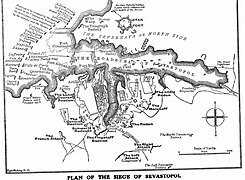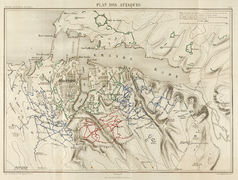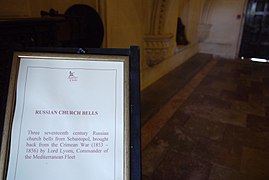Siege of Sevastopol (1854–1855)
| Siege of Sevastopol | |||||||
|---|---|---|---|---|---|---|---|
| Part of theCrimean War | |||||||
 Siege of SevastopolbyFranz Roubaud(detail) | |||||||
| |||||||
| Belligerents | |||||||
|
| |||||||
| Commanders and leaders | |||||||
| Strength | |||||||
|
| ||||||
| Casualties and losses | |||||||
| Total casualties:102,000 killed, wounded, and died from disease[9] | ||||||
Thesiege of Sevastopol(at the time called in English thesiege of Sebastopol) lasted from October 1854 until September 1855, during theCrimean War.The allies (French,Sardinian,Ottoman,andBritish) landed atEupatoriaon 14 September 1854, intending to make a triumphal march toSevastopol,the capital of theCrimea,with 50,000 men. Major battles along the way wereAlma(September 1854),Balaklava(October 1854),Inkerman(November 1854),Tchernaya(August 1855),Redan(September 1855), and, finally,Malakoff(September 1855). During the siege, the allied navy undertook six bombardments of the capital, on 17 October 1854; and on 9 April, 6 June, 17 June, 17 August, and 5 September 1855.
The siege of Sevastopol is one of the last classic sieges in history.[10]The city of Sevastopol was the home of theTsar'sBlack Sea Fleet,which threatened theMediterranean.The Russian field army withdrew before the allies could encircle it. The siege was the culminating struggle for the strategic Russian port in 1854–55 and was the final episode in the Crimean War.
During theVictorian Era,these battles were repeatedly memorialized. The siege of Sevastopol was the subject of Crimean soldierLeo Tolstoy'sSebastopol Sketchesand the subject of the first Russian feature film,Defence of Sevastopol.TheBoulevard de Sébastopol,a major artery in Paris, was named for the victory in the 1850s, while the Battle of Balaklava was made famous byAlfred, Lord Tennyson's poem "The Charge of the Light Brigade"andRobert Gibb's paintingThe Thin Red Line.Apanoramaof the siege itself was painted byFranz Roubaud.
Description[edit]
September 1854[edit]
The allies (French,Ottoman,andBritish) landed atEupatoriaon 14 September 1854.[11]TheBattle of the Alma(20 September 1854), which is usually considered the first battle of theCrimean War(1853–1856), took place just south of theRiver Almain theCrimea.An Anglo-French force underJacques Leroy de Saint ArnaudandFitzRoy Somerset, 1st Baron Raglandefeated GeneralAlexander Sergeyevich Menshikov's Russian army, which lost around 6,000 troops.[12]
Moving from their base atBalaklavaat the start of October, French and British engineers began to direct the building of siege lines along the Chersonese uplands to the south of Sevastopol. The troops preparedredoubts,gun batteries, and trenches.[13]
With the Russian army and its commander Prince Menshikov gone, the defence of Sevastopol was led by Vice AdmiralsVladimir Alexeyevich KornilovandPavel Nakhimov,assisted by Menshikov's chief engineer, Lieutenant ColonelEduard Totleben.[14]The military forces available to defend the city were 4,500 militia, 2,700 gunners, 4,400 marines, 18,500 naval seamen, and 5,000 workmen, totalling just over 35,000 men.[citation needed]
The naval defense of Sevastopol included 8artillery batteries:3 on the north shore (Konstantin Batteryor Fort Constantine, Mikhail battery or Fort Michael, battery no. 4) and 5 on the northern shore (Pavel battery or Fort Pavel, battery no. 8, Alexander battery or Fort Alexander, battery no. 8).
The Russians began byscuttlingtheir ships to protect the harbour, then used their naval cannon as additional artillery and the ships' crews as marines.[15]Those ships deliberately sunk by the end of 1855 includedGrand Duke Constantine,City of Paris(both with120 guns),Khrabryi,Imperatritsa Maria,Chesma,Rostislav,andYagondeid(all 84 guns),Kavarna(60 guns),Konlephy(54 guns), steam frigateVladimir,steamboatsThunderer,Bessarabia,Danube,Odessa,Elbrose,andKrein.[citation needed]
October 1854[edit]
By mid-October, the Allies had some 120 guns ready to fire on Sevastopol; the Russians had about three times as many.[16]
On 5 October (old style date,17 October new style)[a]the artillery battle began.[16]The Russian artillery first destroyed a Frenchmagazine,silencing their guns. British fire then set off the magazine in the Malakoff redoubt, killing Admiral Kornilov, silencing most of the Russian guns there, and leaving a gap in the city's defences. However, the British and French withheld their planned infantry attack, and a possible opportunity for an early end to the siege was missed.[citation needed]
At the same time, to support the Allied land forces, the Allied fleet pounded the Russian defences and shore batteries. Six screw-driven ships of the line and 21 wooden sail were involved in the sea bombardment (11 British, 14 French, and two Ottoman Turkish). After a bombardment that lasted over six hours, the Allied fleet inflicted little damage on the Russian defences and coastal artillery batteries while suffering 340 casualties among the fleet. Two of the British warships were so badly damaged that they were towed to the arsenal in Constantinople for repairs and remained out of action for the remainder of the siege, while most of the other warships also suffered serious damage due to many direct hits from the Russian coastal artillery. The bombardment resumed the following day, but the Russians had worked through the night and repaired the damage. This pattern would be repeated throughout the siege.[citation needed]
November 1854[edit]
In late October and early November, the battles ofBalaclava[17]andInkerman[18]took place beyond the siege lines. Balaclava gave the Russians a morale boost and convinced them that the Allied lines were thinly spread out and undermanned.[11]But after their defeat at Inkerman,[19]the Russians saw that the siege of Sevastopol would not be lifted by a battle in the field, so instead they moved troops into the city to aid the defenders. Toward the end of November, a winter storm ruined the Allies' camps and supply lines. Men and horses sickened and starved in the poor conditions.[20]
While Totleben extended the fortifications around the Redan bastion and the Malakoff redoubt, British chief engineerJohn Fox Burgoynesought to take the Malakoff, which he saw as the key to Sevastopol. Siege works were begun to bring the Allied troops nearer to the Malakoff; in response, Totleben dug rifle pits from which Russian troops could snipe at the besiegers. In a foretaste of thetrench warfarethat became the hallmark of the First World War, the trenches became the focus of Allied assaults.[21]
1855[edit]
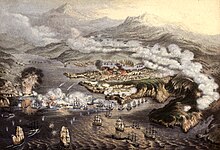
The Allies were able to restore many supply routes when winter ended. The newGrand Crimean Central Railway,built by the contractorsThomas BrasseyandSamuel Morton Peto,which had been completed at the end of March 1855[22]was now in use bringing supplies from Balaclava to the siege lines. The 24-mile long railroad delivered more than five hundred guns and plentiful ammunition.[22]The Allies resumed their bombardment on 8 April (Easter Sunday). On 28 June (10 July), Admiral Nakhimov died from a head wound inflicted by an Allied sniper.[23]
On 24 August (5 September) the Allies started their sixth and the most severe bombardment of the fortress. Three hundred and seven cannon fired 150,000 rounds, with the Russians suffering 2,000 to 3,000 casualties daily. On 27 August (8 September), thirteen Allied divisions and one Allied brigade (total strength 60,000) began the last assault. The Britishassault on the Great Redanfailed, but the French, underGeneral MacMahon,managed toseize the Malakoff redoubtand the Little Redan, making the Russian defensive position untenable. By the morning of 28 August (9 September), the Russian forces had abandoned the southern side of Sevastopol.[9][24]
Although defended heroically and at the cost of heavy Allied casualties, the fall of Sevastopol would lead to the Russian defeat in the Crimean War.[1]Most of the Russian casualties were buried inBrotherhood Cemeteryin over 400 collective graves. The three main commanders (Nakhimov, Kornilov, andIstomin) were interred in the purpose-builtAdmirals' Burial Vault.[citation needed]
Battles during the siege[edit]
- First bombardment of Sevastopol (17 October 1854)
- Battle of Balaclava(25 October 1854)
- Battle of Little Inkerman (26 October 1854)
- Battle of Inkerman(5 November 1854)
- Aborted Russian attack at Balaklava (10 January 1855)
- Battle of Eupatoria(17 February 1855)
- Aborted allied attack at Chernaya (20 February 1855)
- Russian army assaults and seizes the Mamelon (22 February 1855)
- French assault on the "White Works" repulsed (24 February 1855)
- Second bombardment of Sevastopol (9 April 1855)
- British assault "the Rifle Pits" successfully (19 April 1855)
- Battle of the Quarantine Cemetery (1 May 1855)
- Third bombardment of Sevastopol (6 June 1855)
- Allies successfully assault the "White Works", Mamelon and "The Quarries" (8-9 June 1855)
- Fourth bombardment of Sevastopol (17 June 1855)
- Allied assaults on the Malakoff and Great Redan repulsed (18 June 1855)
- Battle of the Chernaya(16 August 1855)
- Fifth bombardment of Sevastopol (17 August 1855)
- Sixth bombardment of Sevastopol (7 September 1855)
- Allies assault theMalakoff,Little Redan, Bastion du Mat and theGreat Redan(8 September 1855)
- Russians retreat from Sevastopol on 9 September 1855
Fate of Sevastopol cannon[edit]

The British sent cannons seized at Sevastopol to many towns in Britain, and several important cities across the Empire.[b][27][28]Additionally, several were sent to theRoyal Military College, Sandhurst,and theRoyal Military Academy, Woolwich.These cannon are now all kept at theRoyal Military Academy Sandhurst(renamed after the closing of RMA Woolwich shortly after the Second World War) and are displayed in front of Old College, next to cannon fromWaterlooand other battles. Many of the cannon sent to towns in Britain were melted down during theSecond World Warto help the war effort, though several of these have subsequently been replaced by replicas.[c][29]
Thecascabel(the large ball at the rear of old muzzle-loaded guns) of several cannon captured during the siege was said to have been used to make the BritishVictoria Cross,the highest award for gallantry in the British Armed Forces. However, Hancocks, the manufacturer, confirms that the metal is Chinese, not Russian, bronze. The cannons used are in the Firepower Museum in Woolwich and are clearly Chinese. There would be no reason why Chinese cannon would be in Sevastopol in the 1850s and it is likely that the VC guns were, in fact, British trophies from the China war in the 1840s held in the Woolwich repository. Though it had been suggested that the VCs should be made from Sevastopol cannons, it seems that in practice, they were not. Testing of medals which proved not to be of Russian bronze has given rise to stories that some Victoria Crosses were made of low grade material at certain times but this is not so – all Victoria Crosses have been made from the same metal from the start.
Components of the 1861Guards Crimean War MemorialbyJohn Bell,in Waterloo Place,St James's,London, were made from melted down Sevastopol cannons.[30]
Sevastopol Bells[edit]
Following the end of the siege, two large bells were taken by British forces aswar trophiesfrom the Church of the Twelve Apostles.[31]Along with two smaller bells, they were appropriated and transported by Lieutenant ColonelJohn St George,who commanded theRoyal Artillerysiege train.[32]They were displayed at theRoyal Arsenal,Woolwich,before the larger one was taken toAldershot Garrison,where it was mounted on a wooden frame on Gun Hill. In 1879, it was moved to the bell tower of the Cambridge Military Hospital, the garrison's medical facility. It was moved in 1978 to the officer's mess in Hospital Road and more recently to St Omer Barracks; it is a Grade IIlisted structure.Thesecond bellwas taken toWindsor Castleand installed in the Round Tower; by tradition it is only rung on the death of a king or queen.[31]
Gallery[edit]
-
Bombardment of Sevastopol byHMSRodney,Crimean War(October 1854)
-
British lithograph published March 1855, after a water-colour byWilliam Simpson,shows winter military housing under construction with supplies borne on soldiers' backs. A dead horse, partially buried in snow, lies by the roadside.
-
A view of the "Valley of the Shadow of Death" near Sevastopol, taken byRoger Fentonin March 1855. It was so named by soldiers because of the number of cannonballs that landed there, falling short of their target, during the siege.[33]
-
Captain Julius Robert's Mortar Boats engaging the quarantine battery – Sebastopol 15 August 1855 – LithographT.G.Dutton
-
Attack on the MalakoffbyWilliam Simpson
-
Siege of Sevastopol 1855by Grigoryi Shukaev
-
Map of Sevastopol
-
Map of the French (blue) and British (red)linesduring the siege. The defenders' positions are in green.
-
Supply lines from the port of Balaklava, 1855. The Grand Crimean Central Railway is shown as "Chemin de Fer Anglais"
-
Monument to the Scuttled Ships, Crimea, Sevastopol. The sculptorAmandus Adamson1905
-
Three 17th Century Russian Orthodox Church Bells inArundel Castle,West SussexUnited Kingdom. These bells were taken as trophies fromSevastopolat the conclusion of the siege of Sevastopol.
-
Three 17th Century Russian Orthodox Church Bells inArundel Castle
-
Three 17th Century Russian Orthodox Church Bells inArundel Castle
-
TheSevastopol MonumentinHalifax, Nova Scotiais the only Crimean War monument in North America.
-
1954 USSR stamp commemorating the siege
See also[edit]
- Sevastopol Sketches,a cycle of three historical fiction short stories written byLeo Tolstoy
- Defence of Sevastopol,Russia's first feature film
Notes[edit]
- ^In this article the first date given is theold style date,the date following is the modern equivalent. Conversions were completed usingCalendar ConverterbyJohn Walker.
- ^Including, in the British Isles:Armagh,Aberdeen,Abingdon-on-Thames,Ashton-under-Lyne,Bamburgh,Banff,Bath,Belfast,Berkswell,Berwick-upon-Tweed,Birkenhead,Birr,Blackburn,Boston,Braddan,Bradford,Bridgnorth,Bridgwater,Brighton,Bristol,Burnley,Caernarfon,Carlisle(possibly),Cambridge,Canterbury(possibly),Cardiff,Cardigan,Carlow,Carmarthen,Chelmsford,Cheltenham,Chester,Chobham,Cobh,Congleton,Cork,Coventry,Cricklade,Darlington,Dartmouth,Darwen(possibly),Derby,Derry,Devizes,Dublin,Dudley,Dumbarton,Dumfries,Dunfermline,Dún Laoghaire,Durham,Edinburgh,Elgin,Ely,Ennis,Eton,Evesham,Flint,Galway,Glasgow,Grantham,Great Yarmouth,Guernsey,Halifax,Harrogate,Hartlepool,Hastings,Hereford,Huntingdon,Knaresborough,Lancaster,Leamington Spa,Leicester,Leominster,Lewes,Lichfield,Limerick,Linlithgow,Lisburn,London,Longton(possibly),Lowestoft,Ludlow,Lymington,Maidstone,Malmesbury,Malton,Margate,Middlesbrough,Monmouth,Newcastle-under-Lyme,Newry,Nottingham,Oldham,Perth,Plymouth,Pontefract,Portlaoise,Portsmouth,Preston,Reading,Retford,Richmond,Ripon,Rochester,Rothesay,Salford,Salisbury,Scarborough,Seaham,Shaftesbury,Sheffield,Southampton,Southport,Southsea,South Shields,Stockport,Stockton-on-Tees,Stoke on Trent(possibly),Sunderland,Swansea(possibly),Taunton,Tiverton,Tralee,Trim,Walsall,Warrington,Waterford,Welling,Wells,Westbury,Whitby,Winchester,Wolverhampton,Wootton Bassett,Wrexham,andYork.[25]Outside the British Isles:Adelaide;Auckland;Brantford, Ontario;Fort Erie, Ontario;Galt, Ontario;Georgetown, Guyana;Gibraltar;Hamilton, Ontario;Hobart,Tasmania;Kincardine, Ontario;Kingston, Ontario;Launceston, Tasmania;London, Ontario;Melbourne;Montreal;Quebec City;Sarnia, Ontario;Stratford, Ontario;Stroud, New South Wales;Sydney;Trois-Rivières, Quebec;Toronto;andWindsor, Ontario.[26]
- ^Those melted down during the Second World War include cannon from:Aberdeen,Ashton-under-Lyne,Blackburn,Boston,Bridgnorth,Bridgwater,Brighton,Bristol,Burnley,Cambridge,Cardiff,Cardigan,Cheltenham,Chester,Chobham,Congleton,Coventry,Cricklade,Derby,Devizes,Dunfermline,Durham,Flint,Halifax,Hastings,Huntingdon,Knaresborough,Lancaster,Leamington Spa,Leominster,Lichfield,Lymington,Malmesbury,Oldham,Ripon,Salford,Salisbury,Seaham,Southport,South Shields,Stockport,Stockton-on-Tees,Sunderland,Warrington,Wells,Whitby,Winchester,Wootton Bassett,Wrexham,andYork.[25] Replica Sevastopol cannons can be found at Beckingham, Bridgwater, Chobham, Hereford, Huntingdon, Preston, Scarborough, South Shields, Stockport, and Sunderland.[25]
References[edit]
- ^abBellamy, Christopher (2001).Richard Holmes(ed.).The Oxford Companion to Military History: Crimean War.Oxford University Press.ISBN0-19-866209-2.
- ^abСоветская Военная Энциклопедия, М., Воениздат 1979, т.7, стр.279
- ^Maule, Fox(1908)."July 1885".In George Douglas; George Dalhousie Ramsay (eds.).The Panmure Papers.London: Hodder and Stoughton.hdl:2027/uc1.b4008335.
- ^David G. Chandler,Atlas of Military Strategy,Lionel Levental Ltd 1980,ISBN0-85368-134-1,p. 146
- ^Blake,The Crimean War,Pen and Sword 1971, p. 114
- ^or 38,000:David G. Chandler,Atlas of Military Strategy,Lionel Levental Ltd 1980,ISBN0-85368-134-1,p. 145
- ^Maria N. Todorova,The Greek Volunteers in the Crimean War ", Balkan Studies, 25(2), 1984, p. 558
- ^John Sweetman,Crimean War, Essential Histories 2,Osprey Publishing, 2001,ISBN1-84176-186-9,p. 89
- ^abСоветская Военная Энциклопедия, М., Воениздат 1979, т.7, стр.280
- ^Elphinstone, H.C (2003).Siege of Sebastopol 1854–55: Journal of the Operations Conducted by the Corps of Royal Engineers.
- ^abFiges, Orlando(2010).The Crimean War: a history.New York:Metropolitan Books.pp. 254, 230.ISBN978-0805074604.
- ^Figes (2010) pp. 208–220
- ^Figes (2010) p. 236
- ^Figes (2010) p. 233.
- ^Figes (2010) p. 224.
- ^abFiges (2010) p. 238.
- ^Engels, Frederick.The War in the East.The Collected Works of Karl Marx and Frederick Engels. Vol. 13. pp. 521–527.
- ^Engels, Frederick.The Battle of Inkerman.The Collected Works of Karl Marx and Frederick Engels. Vol. 13. pp. 528–535.
- ^Frederick Engels, "The Battle of Inkerman" published on 27 November 1854 in theNew York Heraldand carried in theCollected Works of Karl Marx and Frederick Engels: Volume 13,pp. 528–535
- ^Woodford, Alexander(1856),Report of the Board of General Officers Appointed to Inquire into the Statements Contained in the Reports of Sir John McNeill and Colonel Tulloch,London: Eyre and Spottiswoode, pp. 26–30,OCLC62431432
- ^Black, Jeremy(2014) [2001].Western Warfare, 1775–1882.Abingdon, England: Routledge. p. 126.ISBN978-1315710761.
- ^abFiges (2010) p. 356
- ^Figes (2010) p. 378.
- ^Troubetzkoy, Alexis S.(2006).The Crimean War: The Causes and Consequences of a Medieval Conflict Fought in a Modern Age.London: Constable & Robinson. p. 288.
- ^abc"Crimean Cannon International Database: Index of Locations".The Spas Research Fellowship.Retrieved1 October2023.
- ^"Crimean Cannon International Database: Cannons Worldwide Index".The Spas Research Fellowship.
- ^However, there has been controversy about the fate of two cannons that were sent toHalifax, West Yorkshire.As they were removed from a local park and sold for scrap."Two 1799 Russian 24 Pdrs. Watch The St. Lawrence River In Quebec"Archived17 September 2010 at theWayback Machine
- ^"The Russian SBML 18-pr at Waiouru"Archived5 June 2010 at theWayback Machine,Royal New Zealand Artillery Association
- ^Thorsheim, Peter (2015).Waste into Weapons: Recycling in Britain during the Second World War.Cambridge University Press. p. 160.ISBN978-1316395509.
- ^"Guards Crimea Memorial".The London Encyclopaedia(3rd ed.). Pan Macmillan. 2011. p. 541.ISBN9780230738782.
- ^abHistoric England."The Sebastopol Bell (1156129)".National Heritage List for England.
- ^Reilly, W Edmund M (1859).An Account of the Artillery Operations conducted by the Royal Artillery and Royal Naval Brigade before Sebastopol in 1854 and 1855.London: Her Majesty's Stationery Office. p. 251.
- ^Grant, Simon (2005).A Terrible BeautyArchived7 August 2007 at theWayback MachinefromTate etcmagazine, issue 5, accessed 2007-09-27
Further reading[edit]
- Greenwood, Adrian(2015).Victoria's Scottish Lion: The Life of Colin Campbell, Lord Clyde.UK: History Press. p. 496.ISBN978-0-75095-685-7.Archived fromthe originalon 21 February 2016.Retrieved26 November2015.
External links[edit]
- Letters and Papers of Colonel Hugh Robert Hibbert (1828–1895) Mainly relating to service in the Crimean War, 1854–1855.
- Historical Dictionary of the Crimean War
- Henry Ottley. Remarkable Sieges: From The Siege of Constantinople in 1453, To That of Sebastopol, 1854 (1854). 2010.
- Siege of Sevastopol (1854–1855)
- Battles of the Crimean War
- Sieges involving the Russian Empire
- Sieges involving France
- Sieges involving the United Kingdom
- Battles involving the French Foreign Legion
- Taurida Governorate
- Sieges involving the Ottoman Empire
- Naval battles involving the Russian Empire
- Sieges involving the Kingdom of Sardinia
- Military history of Sevastopol


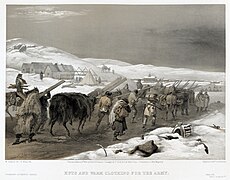
![A view of the "Valley of the Shadow of Death" near Sevastopol, taken by Roger Fenton in March 1855. It was so named by soldiers because of the number of cannonballs that landed there, falling short of their target, during the siege.[33]](https://upload.wikimedia.org/wikipedia/commons/thumb/6/65/Roger_Fenton_-_Shadow_of_the_Valley_of_Death.jpg/237px-Roger_Fenton_-_Shadow_of_the_Valley_of_Death.jpg)



